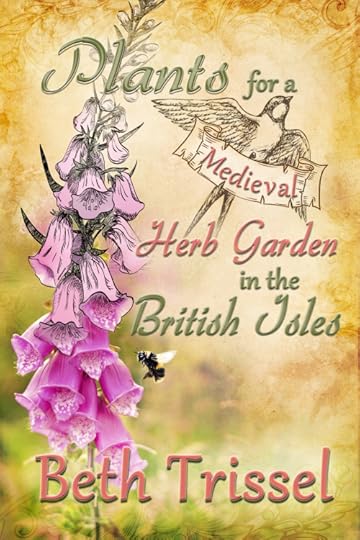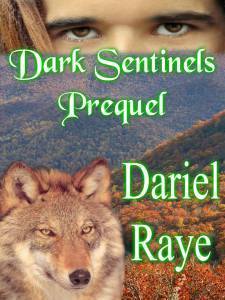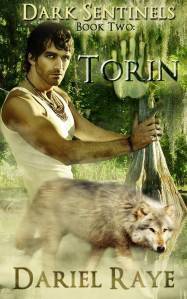Beth Trissel's Blog, page 41
March 11, 2014
‘What Can’t Be Cured, Must Be Endured’ but What if it Could Be?
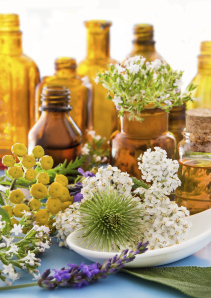 Many folk are fighting respiratory ailments, or flu, these days. Don’t overlook herbs when reaching for a cure.
Many folk are fighting respiratory ailments, or flu, these days. Don’t overlook herbs when reaching for a cure.
In my new herbal, Plants For A Medieval Herb Garden in the British Isles, I covered several plants used in treating colds, coughs, congestion, etc. Some excerpts from the book:
“I often come across references to coltsfoot in my reading. My favorite is related by the beloved British Author Miss Read in her charming books about rural life in the small, fictional village called Thrush Green. In her Thrush Green collection, coltsfoot is a favorite herb in a concoction brewed by the eccentric herbalist, Dotty Harmer. The herb is native to England and Scotland, in grasslands and wastelands. It flowers in early spring and is one of the most popular ingredients in cough remedies. It’s generally given together with other herbs possessing soothing respiratory qualities, such as horehound, marshmallow, and ground ivy. Coltsfoot tea and coltsfoot rock, a confectionery product created from Coltsfoot extract, has long been a remedy for coughs.”
“The tincture of pulsatilla (from the pasque flower) is beneficial in disorders of the mucous membrane, the respiratory, and the digestive passages.
From A Modern Herbal: “A few drops in a spoonful of water will allay the spasmodic cough of asthma, whooping-cough and bronchitis.”
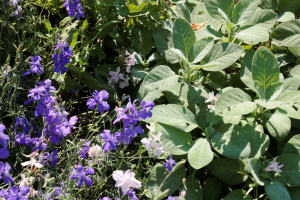 “Why should a man die whilst sage grows in his garden?” ~ Old English Saying
“Why should a man die whilst sage grows in his garden?” ~ Old English Saying
“Sage is wreathed in lore. I love this herb. An old friend, sage always has a place, generally several, in our garden. We grow the traditional variety, also some of the unusual kinds. They rarely survive as well as the old standby, if at all. A centuries’ old tradition recommends planting rue among the sage to keep noxious toads away, but I like toads. They eat mosquitoes and other nasty’s. It was believed sage would thrive or wither as the owner’s business prospered or failed. Man, I hope our plants are alive. I use sage in cooking. The leaves can also be made into a tea for fighting colds. I know a woman who swears sage tea helped her ward off a cold. I don’t doubt her, but the flavor is so strong, I’d be hard-pressed to get my family to drink it.” (Image of sage in our garden with heirloom larkspur)
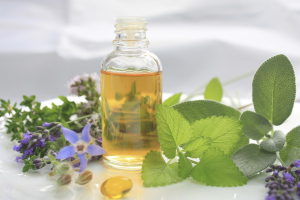 Not in my herbal, because olive trees weren’t widely grown (if at all) in Medieval England or the rest of the British Isles, is Olive Leaf extract. Invaluable. I order mine from Olivus–organic, excellent quality, I get their premium extract. Olive leaf also comes in a tea, but I drink enough tea. I credit olive leaf and green tea with the significant improvement in my blood levels after my 2010 diagnosis of chronic leukemia. Both are powerful antioxidants that help with whatever you’re fighting. (Image of fresh herbs and oil)
Not in my herbal, because olive trees weren’t widely grown (if at all) in Medieval England or the rest of the British Isles, is Olive Leaf extract. Invaluable. I order mine from Olivus–organic, excellent quality, I get their premium extract. Olive leaf also comes in a tea, but I drink enough tea. I credit olive leaf and green tea with the significant improvement in my blood levels after my 2010 diagnosis of chronic leukemia. Both are powerful antioxidants that help with whatever you’re fighting. (Image of fresh herbs and oil)
 In the hit paranormal television show, Grimm, my favorite spot is Rosalee’s Exotic Tea and Spice Shop, filled with herbs. She’s often making an herbal potion or remedy for whatever curse or condition needs curing. They use a lot of herbs on that show–fascinating. For more on Rosalee’s Shop visit the link.
In the hit paranormal television show, Grimm, my favorite spot is Rosalee’s Exotic Tea and Spice Shop, filled with herbs. She’s often making an herbal potion or remedy for whatever curse or condition needs curing. They use a lot of herbs on that show–fascinating. For more on Rosalee’s Shop visit the link.
For some reason, herbs are often associated with the realm of fantasy. But they’re quite real, as are their properties, while sometimes misunderstood and their effects exaggerated. Herbs possess medical attributes of inestimable worth, if used properly and for the right condition.
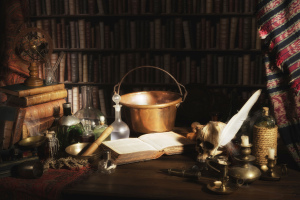 Of course, I had to include a disclaimer in my book so people wouldn’t stupidly overdose on an herb, particularly a poisonous one, but I believe much healing lies in plants. More than we yet know. Medieval monks were amazingly well versed in using medicinal plants. Some of that knowledge was lost with the destruction of the monks and monasteries during the Protestant Reformation. If we recovered all of that ancient knowledge, combined with what we possess now, plus ongoing research, we could cure anything. And we should be doing just that. (Image of old Alchemy laboratory)
Of course, I had to include a disclaimer in my book so people wouldn’t stupidly overdose on an herb, particularly a poisonous one, but I believe much healing lies in plants. More than we yet know. Medieval monks were amazingly well versed in using medicinal plants. Some of that knowledge was lost with the destruction of the monks and monasteries during the Protestant Reformation. If we recovered all of that ancient knowledge, combined with what we possess now, plus ongoing research, we could cure anything. And we should be doing just that. (Image of old Alchemy laboratory)
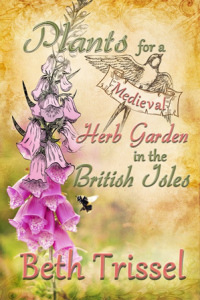 Daughter Elise is formatting my herbal for print, but the fully illustrated version is available in kindle now with 199 pages and over 100 images. ‘The major focus of this work is England and Scotland, but also touches on Ireland and Wales. Information is given as to the historic medicinal uses of these plants and the rich lore surrounding them. Journey back to the days when herbs figured into every facet of life, offering relief from the ills of this realm and protection from evil in all its guises.’
Daughter Elise is formatting my herbal for print, but the fully illustrated version is available in kindle now with 199 pages and over 100 images. ‘The major focus of this work is England and Scotland, but also touches on Ireland and Wales. Information is given as to the historic medicinal uses of these plants and the rich lore surrounding them. Journey back to the days when herbs figured into every facet of life, offering relief from the ills of this realm and protection from evil in all its guises.’
***Elise did the stunning cover. The book is 2.99 which doesn’t even cover the cost of a single image. Here’s the Amazon Kindle Link.
Filed under: Uncategorized Tagged: alternative medicine, Grimm, herbal medicine, herbal treatment, medicinal herbs, medieval herb garden, new herbal release, old herbal, Rosalee's spice shop


March 7, 2014
For the Loveliness of it All
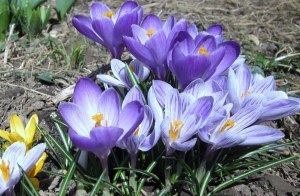 I love spring anywhere, but if I could choose I would always greet it in a garden. ~Ruth Stout
I love spring anywhere, but if I could choose I would always greet it in a garden. ~Ruth Stout
Why, some of you may ask, am I so drawn to gardening? Granted, toiling in the earth has its downsides, like the aching back I will soon be complaining of, the chewing bugs, and inevitable weather affronts, but nothing is more uplifting to the spirit than a fair day in and among growing things. The joyous sights of new life returning to our beautiful valley after a long winter, the delectable scents and sounds…the trill of a meadowlark, the song sparrow singing overhead as I plant seeds in the crumbly brown ground…the swoop and soaring of the first butterfly…the pussy willow bursting with fuzzy catkins…the glowing crocus. Snow still obscures the landscape and cold wind nips my face, but the forecast promises better days and I shall soon be out sniffing the air with profound appreciation. The barnyard geese are fussy. Egg laying shall commence.
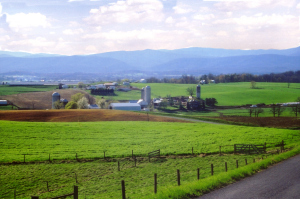 The delights of spring are almost upon us. There’s always a moment that catches and holds me transfixed, and in that moment, all is perfect. All is lovely. My piece of heaven on earth.~
The delights of spring are almost upon us. There’s always a moment that catches and holds me transfixed, and in that moment, all is perfect. All is lovely. My piece of heaven on earth.~
***Images of crocus from last year and spring in the valley taken by my mom in past years.
Filed under: Uncategorized Tagged: country life, Crocus, gardening in the Shenandoah Valley, geese, pussywillow, spring, Virginia


March 3, 2014
“Good apple pies are a considerable part of our domestic happiness.” ~ Jane Austen
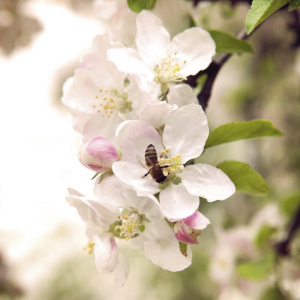 With a foot of snow on the ground and near zero temps, this seems an apt time for an excerpt from my new herbal, Plants For A Medieval Herb Garden in the British Isles. The kindle version is out now; daughter Elise is formatting the print book. Lots of images to fit in. And now–apples. Bet you didn’t know they belonged in an herbal.
With a foot of snow on the ground and near zero temps, this seems an apt time for an excerpt from my new herbal, Plants For A Medieval Herb Garden in the British Isles. The kindle version is out now; daughter Elise is formatting the print book. Lots of images to fit in. And now–apples. Bet you didn’t know they belonged in an herbal.
The history and lore behind apples is fascinating. And we all know what Johnny Appleseed thought vital to plant in America. The thing that most struck me in reading about apples, is how the history of the apple is closely linked with the history of man. From the earliest times, wherever people went, the apple went, and is associated with peace and a gentler life. If folk settled down, built a cottage and planted apple trees, that spoke to domesticity and disinterest in warfare. Maybe more people should plant them today. I do. And then all hold hands and sing the Johnny Appleseed Blessing to help bring about world peace.
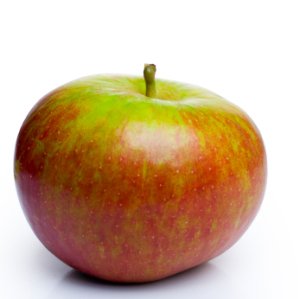 Back to apples. These early cultivars weren’t the sweet fruit we know today, but much smaller and tarter. In the Middle Ages, most apples were made into cider. By Shakespeare’s day, the new varieties were referred to as ‘dessert apples’ and served accompanied by caraway. Apples were probably introduced into Britain by the Romans and have a long history of use there. In the Scottish Highlands, the crabapple tree is the badge of the Lamont clan.
Back to apples. These early cultivars weren’t the sweet fruit we know today, but much smaller and tarter. In the Middle Ages, most apples were made into cider. By Shakespeare’s day, the new varieties were referred to as ‘dessert apples’ and served accompanied by caraway. Apples were probably introduced into Britain by the Romans and have a long history of use there. In the Scottish Highlands, the crabapple tree is the badge of the Lamont clan.
(Image of Cox’s Orange Pippin, an old heirloom apple)
From A Modern Herbal: “The chief dietetic value of apples lies in the malic and tartaric acids. These acids are of benefit to persons of sedentary habits, who are liable to liver derangements, and they neutralize the acid products of gout and indigestion. (You don’t want a deranged liver).
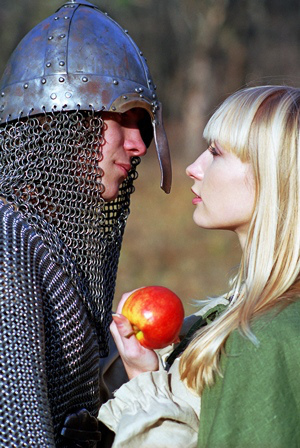 Apple cookery is very early English: Piers Ploughman mentions ‘all the povere peple’ who ‘baken apples broghte in his lappes’ and the ever popular apple pie was no less esteemed in Tudor times than it is today, only our ancestors had some predilections in the matter of seasonings that might not now appeal to all of us, for they put cinnamon and ginger in their pies and gave them a lavish colouring of saffron. The original pomatum seems to date from the herbalist Gerard’s days (1545-1612), when an ointment for roughness of the skin was made from apple pulp, swine’s grease, and rosewater. The Apple will also act as an excellent dentifrice.”
Apple cookery is very early English: Piers Ploughman mentions ‘all the povere peple’ who ‘baken apples broghte in his lappes’ and the ever popular apple pie was no less esteemed in Tudor times than it is today, only our ancestors had some predilections in the matter of seasonings that might not now appeal to all of us, for they put cinnamon and ginger in their pies and gave them a lavish colouring of saffron. The original pomatum seems to date from the herbalist Gerard’s days (1545-1612), when an ointment for roughness of the skin was made from apple pulp, swine’s grease, and rosewater. The Apple will also act as an excellent dentifrice.”
(Image of a knight, his lady, and an apple)
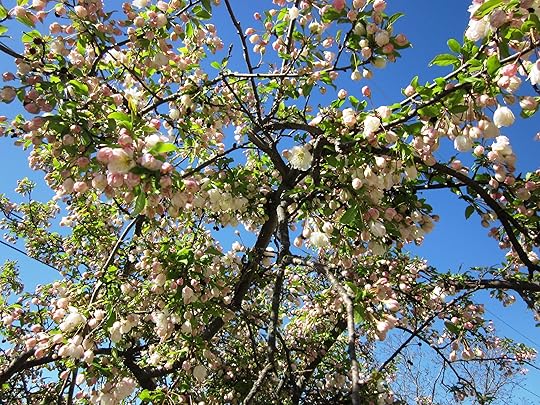 From The Family Herbal: “The juice is cooling, and is good externally used in eruptions on the skin, and in diseases of the eyes, where a sharp humour is troublesome.”
From The Family Herbal: “The juice is cooling, and is good externally used in eruptions on the skin, and in diseases of the eyes, where a sharp humour is troublesome.”
(Crab apple in our yard)
“Even if I knew that tomorrow the world would go to pieces, I would still plant my apple tree.” ~Martin Luther
Filed under: Uncategorized Tagged: apple trees, apples, Cox's Orange Pippin, England, heirloom, herbal lore, history of apples, medicinal use of apples, medieval


February 27, 2014
New Release! Plants For A Medieval Herb Garden in the British Isles
I finally did it! After abundant research, writing, and seemingly endless revising, my first herbal is available in kindle at Amazon. I initially embarked on this undertaking last year for the workshop I gave focused on herbs and medicinal plants of the British Isles. Participants were so enthusiastic, as have been many of you who follow this blog, that I was inspired to go all out and turn this project into a much longer work. No small effort, but I enjoyed the process and learned a lot along the way. I’m always learning because this is such a vast trove of material to delve into. I’ve also had fun choosing images lo illustrate this book. Some are photographs of our garden taken by Elise, many are royalty free images I purchased, and a few are in public domain. I hope you enjoy Plants For A Medieval Herb Garden in the British Isles. A lot of these plants were brought to America with the early colonists and are widespread here now. Others are well and truly British and Scottish.
Elise did the gorgeous cover.
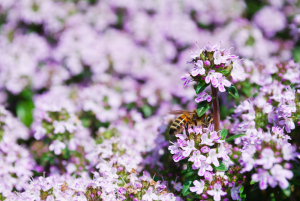 Book Description: An illustrated collection of plants that could have been grown in a Medieval Herb or Physic Garden in the British Isles. The major focus of this work is England and Scotland, but also touches on Ireland and Wales. Information is given as to the historic medicinal uses of these plants and the rich lore surrounding them. Journey back to the days when herbs figured into every facet of life, offering relief from the ills of this realm and protection from evil in all its guises.~
Book Description: An illustrated collection of plants that could have been grown in a Medieval Herb or Physic Garden in the British Isles. The major focus of this work is England and Scotland, but also touches on Ireland and Wales. Information is given as to the historic medicinal uses of these plants and the rich lore surrounding them. Journey back to the days when herbs figured into every facet of life, offering relief from the ills of this realm and protection from evil in all its guises.~
Filed under: Uncategorized Tagged: Gardening, herb garden, herbal lore, Herbs of the Middle Ages, Irish herbs, Medicinal uses of herbs, medieval herb garden, nonfiction, physic garden, Scottish herbs


February 21, 2014
Step Into the Garden With Meriwether & Jeremiah from Colonial American Romance Novel Enemy of the King
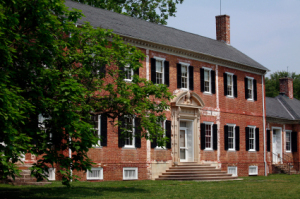 Stone lions the size of wolfhounds sat on either side of the imposing front door as if to devour unwanted guests. Perhaps Jeremiah enjoyed their significance. He seldom entertained and seemed happier seated astride a horse than in the company of most ladies and gentlemen. He turned the marble knob and led Meriwether out onto the crescent-shaped balcony.
Stone lions the size of wolfhounds sat on either side of the imposing front door as if to devour unwanted guests. Perhaps Jeremiah enjoyed their significance. He seldom entertained and seemed happier seated astride a horse than in the company of most ladies and gentlemen. He turned the marble knob and led Meriwether out onto the crescent-shaped balcony.
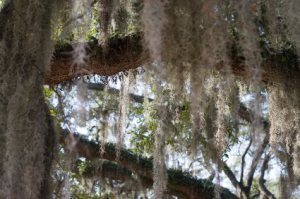 He leaned momentarily on the iron railing. “Feel that breeze.”
He leaned momentarily on the iron railing. “Feel that breeze.”“Delightful.” The cool wind fanned her hot cheeks.
Lifting her skirts, she walked arm in arm with him down the brick steps of the gracious Georgian-style home. Pleasant Grove had been built by his grandfather on a bluff above the Santee River and fashioned after the manor in Kent that Lord Jordan had been forced to flee in 1647 after fighting with Charles I, who lost his kingdom and his head. Fortunately Jeremiah’s Royalist ancestor had fared better than the ill-fated king and escaped to America with his young wife and her jewels. But his near capture by Cromwell and the loss of everything else had given him a wariness he’d passed to his descendants.
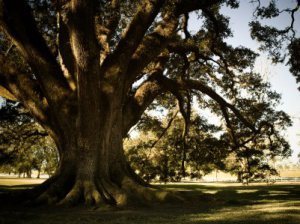 Was Jeremiah secretly opposing a different king?
Was Jeremiah secretly opposing a different king?She cocked her head at him a little apprehensively. “Is there anywhere in particular you’re taking me?”
He smiled as if to reassure her. “Just farther in.”
“As you wish.” Being out here alone with him was like being in a glistening Eden. A thrush warbled from high above them in the live oak. Green-gray moss hung from its far-reaching branches and blew in the breeze, reminding her of the McChesney, her father’s largest ship, its sails billowing.
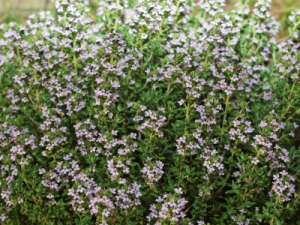 Jeremiah held her back, the warmth of his hand radiating through her sleeve. “You’ll spoil those fine shoes.” He led her around the sprawling puddle she hadn’t noticed and onto the green mat creeping over the path.
Jeremiah held her back, the warmth of his hand radiating through her sleeve. “You’ll spoil those fine shoes.” He led her around the sprawling puddle she hadn’t noticed and onto the green mat creeping over the path.The fragrant thyme scented the air as they trod on the tiny leaves and wound deeper into the garden. Newly washed hollyhocks, rosy balsam, and wine-red salvia gleamed. The glowing colors, heady fragrances, her arm tingling at his touch…stirred a pulsing awareness in Meriwether that she’d never felt in the house.
There was so much she wanted to say, to ask, but couldn’t, and she darted glances at him.
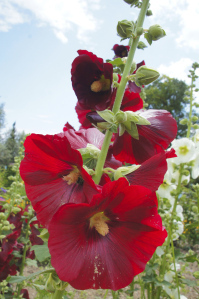 He caught her eye. “What are you thinking?”
He caught her eye. “What are you thinking?”“Nothing of consequence,” she almost stuttered.
He quirked his left eyebrow at her; the narrow scar gave it a slightly crooked rise. “And earlier in the parlor?”
She glanced away from his searching gaze and focused on the toe of his boot. “Just chatter.”
“Are you truly worried?”
“Only as much as anyone these days.” Still evading his scrutiny, she bent and plucked a sweetly-scented nicotiana blossom.
He took the white flower from her hand as she straightened, setting her skin afire, and tucked it behind her ear. “I sense there’s much left unsaid. Why won’t you speak?”
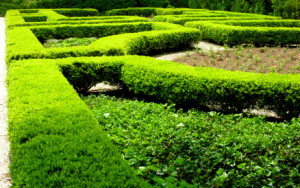 Still battling the near irresistible draw of those blue eyes, she stared at his open neckline. “I prefer to listen.”
Still battling the near irresistible draw of those blue eyes, she stared at his open neckline. “I prefer to listen.”“Yet I would know what fills your fair head.”
“Perhaps you already do,” she said, hastily shifting her inspection from his bronzed chest back to the snowy blossoms.
His voice lowered even further. “No. You are not so easily read.”
Jeremiah grew silent and led her into the avenue, as he called it, strolling with her between rows of English boxwood that reached up over their heads. The clipped shrubs exuded the warm Old World scent Meriwether remembered from childhood.
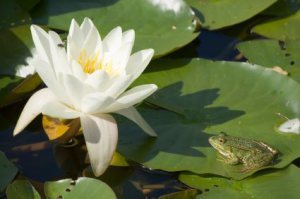 “Stay a moment,” he said, stopping beside the fish pool. The statue of his father’s favorite spaniel sat on the pebble path beside the water, a whimsical touch. The brown stone was flecked with moss, as was anything that sat out of doors too long, but the cocker seemed as if he really were intent on the water.
“Stay a moment,” he said, stopping beside the fish pool. The statue of his father’s favorite spaniel sat on the pebble path beside the water, a whimsical touch. The brown stone was flecked with moss, as was anything that sat out of doors too long, but the cocker seemed as if he really were intent on the water.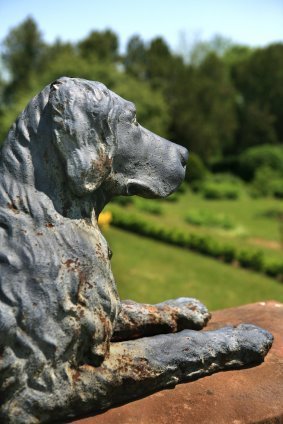
She patted his granite ears and sighed. How could she confide her deepest longing and her fears?
“Such a weighty sigh. Has our walk overtaxed you?”
She lifted her gaze to his, bracing herself under the force of his study. “No. I’m much stronger now.”
“Good. You seem so. You were as weak as a newborn kitten when I first found you.”
“I only remember that you brought me here in your boat.”
He scooped up a pebble, tossing it into the pool. Goldfish scattered, and a little green frog plopped in among the lilies. “Charles Town is a graveyard. Thank God yours has not swelled the family plot.”
The intensity in his voice took her by surprise.
“Are you content at Pleasant Grove, Miss Steele?”
“Yes,” she answered in growing confusion.
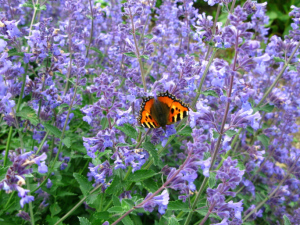 “Entirely?”
“Entirely?”She shied away from his inquiry and watched goldfish rippling through the water like orange silk. “Why doubt me?”
“I must know.”
His earnestness made her stomach churn. “For my part,
I am content. I trust you don’t find my presence burdensome?”
“Not yet,” he said gravely.
Her eyes startled back to his. “Do you think I will become so?”
“Quite possibly.”
****
1780 South Carolina, spies and intrigue, a vindictive ghost, the battle of King’s Mountain, Patriots and Tories, pounding adventure, pulsing romance…ENEMY OF THE KING.
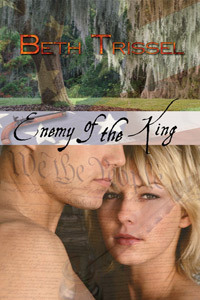 ‘Enemy of the King is an amazing and vibrant look into the American Revolutionary War and tells the story through the eyes of a remarkable woman. While Jeremiah Jordan himself is a strong soldier and heroic patriot, it is Meriwether Steele who makes such a great impression in this epic novel. Her dedication to the man she loves, the lengths she must go to defend herself and others, and the unstoppable force that she is makes Meriwether one heck of a heroine. Ms. Trissel brings the countryside and its people alive with her fascinating and at times gory details. This sexy historical book is a must read!’
‘Enemy of the King is an amazing and vibrant look into the American Revolutionary War and tells the story through the eyes of a remarkable woman. While Jeremiah Jordan himself is a strong soldier and heroic patriot, it is Meriwether Steele who makes such a great impression in this epic novel. Her dedication to the man she loves, the lengths she must go to defend herself and others, and the unstoppable force that she is makes Meriwether one heck of a heroine. Ms. Trissel brings the countryside and its people alive with her fascinating and at times gory details. This sexy historical book is a must read!’ ~ Danielle, Reviewer for Coffee Time Romance & More~
~ Danielle, Reviewer for Coffee Time Romance & More~Filed under: Uncategorized Tagged: Carolina backcountry, Excerpt from Colonial American Romance Novel Enemy of the King, Excerpt from historical romance novel, The American Revolution, The Patriot


February 19, 2014
New Release Bash: “Dark Sentinels Prequel” by Dariel Raye
Welcome to my friend, Dariel Raye, here to tell us about her new release and a bit about the others.
Dariel: In response to readers’ questions and requests, there’s a new addition to my award-winning “Dark Sentinels” series! “Dark Sentinels Prequel” is LIVE. Here’s the cover and blurb for the new release as well as information about other available books in the series.
Sometimes a girl has to go the extra mile to capture the man she loves, especially when she’s a sentinel wolf shifter from Washington state with no possible mates for miles.
Orphaned in childhood, Dr. Syreena Adler learned at an early age to depend on her twin brother, Sable, and herself, but phone conversations with a Georgia sentinel she’s never seen spark unexpected desire.
Southern red wolf sentinel Cord Velasquez has spent his life atoning for the death of his entire family. He wants a life with Syreena, but when she surprises him with an impromptu visit, the realization of his greatest fear seems inevitable.
Dark Sentinels Book One: Sable
Sable, a sentinel wolf shifter, is captured and locked in his wolf form until Akila, a veterinarian, tries to tame him and unleashes a 6’5″ baby blue-eyed surprise.
Dr. Akila Marshall is a veterinarian with a calling – save as many stray animals as possible. The only child of wealthy, yet distant parents, she’s convinced that love is not for her. Until…
Sable’s search for his twin sister leads him to Akila. Born into a rare species of wolf shifters whose main purpose is protecting others, he has always been forced to fend for himself, but Akila’s loving, protective nature draws him – and not a moment too soon. Together, they must learn to trust each other enough to overcome a new, deadly enemy.
“Dark Sentinels Book Two: Torin”
When greedy land developers set their sights on Dark Sentinel land, Torin turns to attorney Stephanie Bates for help, but she’ll need his protection to stay alive long enough to save his land.
Real estate lawyer, Stephanie Bates, has risen to the top of her field through meticulous sacrifice and goal setting. She has no time for distractions – and that includes pets, messy relationships, and loose ends.
Torin DuMont is a forensic scientist who chose the profession to avoid dealing with people as much as possible. Raised by a stepfather who hated him, he’s been forced to live a life of solitude, fueled by anger and distrust. When wolves and shifters start turning up dead, Torin must battle an enemy bent on destroying those he was born to protect. His greatest challenge, however, is Attorney Bates and the surprising effect she has on his heart.
On the Web
Dariel’s Blog Dariel’s Website
Dariel’s Newsletter Dariel on Twitter
Facebook Page Dariel’s Amazon Author Page
Dariel on Goodreads The Romance Troupe
About the Author
 Dariel loves books, animals, and all things paranormal. Dariel has written articles for The News Item of Mobile, and Black Health Magazine of Atlanta. A classically trained pianist and vocalist with a degree in piano and vocal performance and a master’s in counseling psychology, she completed studies for a Ph.D. with the exception of her dissertation. She is presently writing a shifter romance series, “Dark Sentinels,” two Nephilim series with vamp-like heroes, “The Alerians” and “Children of Cain,” several erotic paranormal/fantasy romances inspired by blog flashes, and an erotic fantasy newsletter serial. Lives with a very spoiled Dobie/Coonhound and a passel of black cats. To learn more about Dariel and her books, visit her blog and join her newsletter.
Dariel loves books, animals, and all things paranormal. Dariel has written articles for The News Item of Mobile, and Black Health Magazine of Atlanta. A classically trained pianist and vocalist with a degree in piano and vocal performance and a master’s in counseling psychology, she completed studies for a Ph.D. with the exception of her dissertation. She is presently writing a shifter romance series, “Dark Sentinels,” two Nephilim series with vamp-like heroes, “The Alerians” and “Children of Cain,” several erotic paranormal/fantasy romances inspired by blog flashes, and an erotic fantasy newsletter serial. Lives with a very spoiled Dobie/Coonhound and a passel of black cats. To learn more about Dariel and her books, visit her blog and join her newsletter.
Rafflecopter: Starts 2/13/2014 – check my blogger site for tour hosts!
Filed under: Uncategorized Tagged: Dariel Raye, fantasy, New release, paranormal romance, romance, shapeshifter, wolves


February 15, 2014
The Story Behind Award-Winning Historical Romance Enemy of the King–Featured at The Fussy Librarian
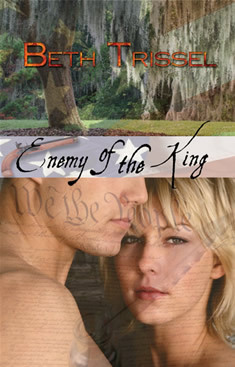 Years ago, I was researching my early American Scots-Irish forebears and often came across references to a battle fought during the Revolution called the Battle of Kings Mountain. The name alone drew me. I vowed to go back later and research it more in-depth and uncovered fascinating fodder for the imagination.
Years ago, I was researching my early American Scots-Irish forebears and often came across references to a battle fought during the Revolution called the Battle of Kings Mountain. The name alone drew me. I vowed to go back later and research it more in-depth and uncovered fascinating fodder for the imagination.I learned about the gallant, ill-fated British Major Patrick Ferguson who lost his life and Loyalist army atop that Carolina Mountain (large knob, really) called King’s back in the fall of 1780. Ferguson is buried there beneath a stone cairn, possibly along with his mistress who also fell that day. He had two, both called Virginia, but it’s believed one mistress made her escape on a horse by betraying his whereabouts to the advancing Patriots. I guess she figured better him than her and he was going down anyway…
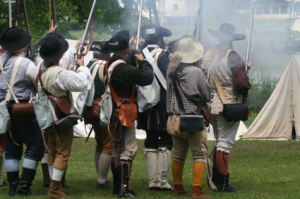 Speaking of which, I discovered the hardy, sometimes downright mean, Overmountain men of Scots heritage didn’t take kindly to Ferguson’s warning that they desist from rebellion or he’d bring fire and sword upon them and hang all their leaders, all these ‘enemies of the King!’
Speaking of which, I discovered the hardy, sometimes downright mean, Overmountain men of Scots heritage didn’t take kindly to Ferguson’s warning that they desist from rebellion or he’d bring fire and sword upon them and hang all their leaders, all these ‘enemies of the King!’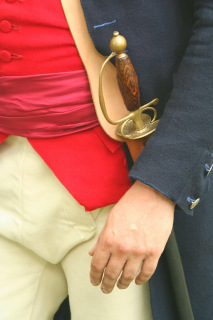
‘Book title,’ I said to self. And Enemy of the King sounds much cooler than The Patriot. So I began what came to be my version of that famous book/film, though I’d started my novel before it even came out. Years of research went into the high drama and romance of the Revolution.
Needless to say, the Battle of Kings Mountain, a mega conflict that altered the course of a nation, plays a prominent role in this fast-paced Historical Romance. And, being drawn to mysterious old homes and the notion that those who’ve gone before us aren’t always gone, I included a ghost.
(Image of British officer)
 I also suspect my ancestors are speaking to me, as I have a colonial forebear named Jeremiah Jordan and discovered an early Meriwether in the family. Not to mention a British general whose grandson was fighting with George Washington. My journey back through time gathered intrigue, and I wondered how the people who lived through anything as all-consuming as the American Revolution ever got their lives back to normal. The ripples from that enormous upheaval are still flowing out in concentric circles. They’ve certainly encompassed me, and now I’m at work on the sequel.
I also suspect my ancestors are speaking to me, as I have a colonial forebear named Jeremiah Jordan and discovered an early Meriwether in the family. Not to mention a British general whose grandson was fighting with George Washington. My journey back through time gathered intrigue, and I wondered how the people who lived through anything as all-consuming as the American Revolution ever got their lives back to normal. The ripples from that enormous upheaval are still flowing out in concentric circles. They’ve certainly encompassed me, and now I’m at work on the sequel.****
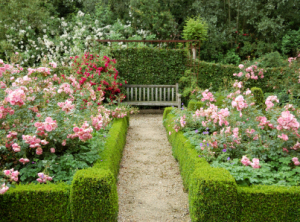 So, step into the elegant parlor of Pleasant Grove, an eighteenth
century Georgian plantation built high on the bluff above the Santee River. Admire the stately lines of this gracious brick home and its exquisite decor. Stroll out into the expansive garden between fragrant borders of lavender and rosemary. Bask beneath the moss-hung branches of an enormous live oak, then saunter back indoors to dress for a candlelight dinner in the sumptuous dining room. But don’t plan on a lengthy stay, you’re about to be snatched away for a wild ride into Carolina backcountry.
So, step into the elegant parlor of Pleasant Grove, an eighteenth
century Georgian plantation built high on the bluff above the Santee River. Admire the stately lines of this gracious brick home and its exquisite decor. Stroll out into the expansive garden between fragrant borders of lavender and rosemary. Bask beneath the moss-hung branches of an enormous live oak, then saunter back indoors to dress for a candlelight dinner in the sumptuous dining room. But don’t plan on a lengthy stay, you’re about to be snatched away for a wild ride into Carolina backcountry.****
 Jeremiah Jordan is a Patriot and Meriwether Steele a Loyalist. She risks a traitor’s death if she fights for the one she loves.
Jeremiah Jordan is a Patriot and Meriwether Steele a Loyalist. She risks a traitor’s death if she fights for the one she loves.‘South Carolina, spies and intrigue, a vindictive ghost, the battle of King’s Mountain, Patriots and Tories, pounding adventure, pulsing romance…ENEMY OF THE KING.’
 The year is 1780, one of the bloodiest of the American Revolution. The entire Southern garrison has been captured and Lord Cornwallis is marching his forces deep into South Carolina. ‘Bloody Ban’ Lieutenant Major Banestre Tarleton and his infamous Legion are sweeping through the countryside. Revenge is the order of the day on both sides and rugged bands of militia are all that stand between crown forces and utter defeat.
The year is 1780, one of the bloodiest of the American Revolution. The entire Southern garrison has been captured and Lord Cornwallis is marching his forces deep into South Carolina. ‘Bloody Ban’ Lieutenant Major Banestre Tarleton and his infamous Legion are sweeping through the countryside. Revenge is the order of the day on both sides and rugged bands of militia are all that stand between crown forces and utter defeat.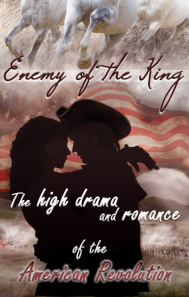 ***Enemy of the King is featured today, Feb. 15th, at the Fussy Librarian (in an email notification). ‘Bewildered by the number of ebooks out there? Choose from 40 genres, select content preferences, and www.TheFussyLibrarian.com emails you.’ daily deals.
***Enemy of the King is featured today, Feb. 15th, at the Fussy Librarian (in an email notification). ‘Bewildered by the number of ebooks out there? Choose from 40 genres, select content preferences, and www.TheFussyLibrarian.com emails you.’ daily deals.***ENEMY OF THE KING is available at in print and eBook at Amazon and The Wild Rose Press. In eBook at Barnes & Noble’s Nookbook, All Romance eBooks, and many other online booksellers.
***I’m taking this opportunity to announce that I’ve signed a contract with the Wild Rose Press for Traitor’s Legacy, the sequel to Enemy of the King, more on that novel soon. Expected release date–August!
Filed under: Uncategorized Tagged: Best Historical romance novels, Colonial America, Colonial American Romance, Historical Romance, Loyalist, Patriot, researching historicals, The American Revolution, The Fussy Librarian, the Scots-Irish


February 10, 2014
I’m Calling it–Spring!
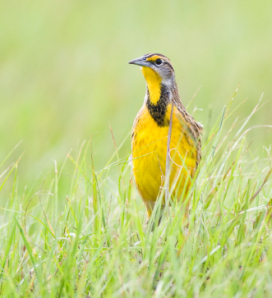 Spring is when the meadowlark sings and I heard one in the field across the road from our farm this morning while out walking the dogs. I stopped and listened closely to be certain I’d heard right. Yep, three more unmistakable trills floated on the cold air. In full-blown spring, those sweet calls resound from various places in our meadow and the neighbor’s. Tracking down the elusive songster is almost like trying to catch a leprechaun. Getting a photograph of a meadowlark has long been a goal of mine and daughter Elise’s. We have yet to succeed. Still, hope, like spring, reigns eternal. Yes, we have snow and more biting temps in the forecast, but the barnyard geese are getting fussy and pairing off, our earliest indication of the renewal of the earth, and now the meadowlark has proclaimed the end of a brutal winter is in sight. (*Image of meadowlark I purchased)
Spring is when the meadowlark sings and I heard one in the field across the road from our farm this morning while out walking the dogs. I stopped and listened closely to be certain I’d heard right. Yep, three more unmistakable trills floated on the cold air. In full-blown spring, those sweet calls resound from various places in our meadow and the neighbor’s. Tracking down the elusive songster is almost like trying to catch a leprechaun. Getting a photograph of a meadowlark has long been a goal of mine and daughter Elise’s. We have yet to succeed. Still, hope, like spring, reigns eternal. Yes, we have snow and more biting temps in the forecast, but the barnyard geese are getting fussy and pairing off, our earliest indication of the renewal of the earth, and now the meadowlark has proclaimed the end of a brutal winter is in sight. (*Image of meadowlark I purchased)
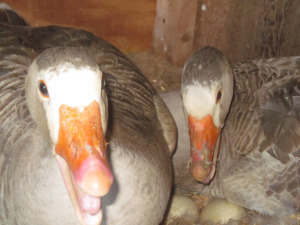 The dogs and I tramped the yard to survey my dormant flower beds. I wonder how many plants will return after the frigid cold that engulfed the Shenandoah Valley these past weeks. The vegetable garden should be sporting the promise of a glorious cover crop of crimson clover, but the seedlings I knocked myself out to establish last fall are conspicuous by their absence. I will try again next fall. Over the weekend, Elise and I poured over seed catalogs and sent off several orders. I plan to start seeds in my little greenhouse later this month or the first of March. It’s solar, without an alternate heat source, so not much point in starting anything before then. If we really want it going all winter, we will have to install some kind of heat. As it is, the greenhouse is frozen out, so any bugs and diseases that might have lingered from last year are well and truly zapped. One advantage of a severe cold snap.
The dogs and I tramped the yard to survey my dormant flower beds. I wonder how many plants will return after the frigid cold that engulfed the Shenandoah Valley these past weeks. The vegetable garden should be sporting the promise of a glorious cover crop of crimson clover, but the seedlings I knocked myself out to establish last fall are conspicuous by their absence. I will try again next fall. Over the weekend, Elise and I poured over seed catalogs and sent off several orders. I plan to start seeds in my little greenhouse later this month or the first of March. It’s solar, without an alternate heat source, so not much point in starting anything before then. If we really want it going all winter, we will have to install some kind of heat. As it is, the greenhouse is frozen out, so any bugs and diseases that might have lingered from last year are well and truly zapped. One advantage of a severe cold snap.
(*Nesting geese from last spring. Image by my husband, Dennis)
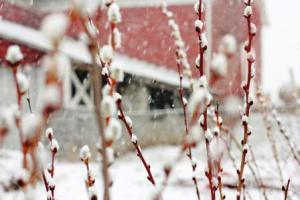 Another early sign of spring is the pussy willow in the back garden. Fuzzy grey buds are beginning to swell. Last year, I planted several pussy willows I’d rooted from cuttings down by the pond. I ought to trek over there and see if any of them made it. I’ll report back, and, if they didn’t, I shall persevere. (*Image of pussy willow by the old red barn from last spring by Elise)
Another early sign of spring is the pussy willow in the back garden. Fuzzy grey buds are beginning to swell. Last year, I planted several pussy willows I’d rooted from cuttings down by the pond. I ought to trek over there and see if any of them made it. I’ll report back, and, if they didn’t, I shall persevere. (*Image of pussy willow by the old red barn from last spring by Elise)
Onward ho.
Filed under: Uncategorized Tagged: Barnyard Geese, country life, Eastern Meadowlark, farm life, Gardening, pussywillow, spring, starting seeds, The Shenandoah Valley, Virginia


February 6, 2014
‘Honey of Roses’ and The Family Herbal by Sir John Hill
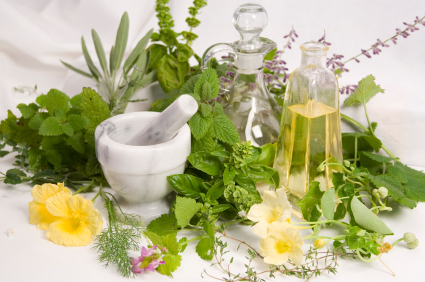 18th century botanist Sir John Hill, also an apothecary, playwright, actor, novelist, and journalist, was quite an accomplished gentleman. Sir John is also among the most vilified men in Georgian England for his attacks on the Royal Society, with whom he was at odds. Disappointed by the society’s refusal to elect him a fellow, coupled with his disapproval of their scientific standards, Hill wrote many strongly worded reviews of the lauded society. And they weren’t the only ones to come under fire by Hill, outspoken to a fault. He was attacked in turn, but back to his charming and informative work, The Family Herbal.
18th century botanist Sir John Hill, also an apothecary, playwright, actor, novelist, and journalist, was quite an accomplished gentleman. Sir John is also among the most vilified men in Georgian England for his attacks on the Royal Society, with whom he was at odds. Disappointed by the society’s refusal to elect him a fellow, coupled with his disapproval of their scientific standards, Hill wrote many strongly worded reviews of the lauded society. And they weren’t the only ones to come under fire by Hill, outspoken to a fault. He was attacked in turn, but back to his charming and informative work, The Family Herbal.
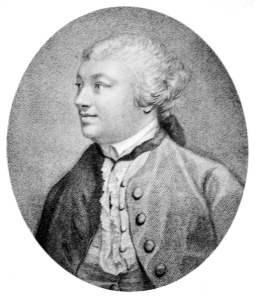 Hill states his herbal is intended to inform those who live in the country and are desirous of being useful to their families and friends, or charitable to the poor in relief of their disorders, of the virtues of wild plants, and describes his book as, ‘An account of all those English plants which are remarkable for their virtues, and of the drugs which are produced by vegetables of other countries: with their descriptions and their uses, as proved by experience.’
Hill states his herbal is intended to inform those who live in the country and are desirous of being useful to their families and friends, or charitable to the poor in relief of their disorders, of the virtues of wild plants, and describes his book as, ‘An account of all those English plants which are remarkable for their virtues, and of the drugs which are produced by vegetables of other countries: with their descriptions and their uses, as proved by experience.’
He prefaces his herbal with detailed explanations as to which part of the plant is used and the steps in preparing the desired form for administering its healing properties. I’ve spent hours reading over these and writing them up. Fascinating stuff that now forms a new session in the herbal lore workshops I give, the next one for Celtic Hearts Romance Writers in May (also open to nonmembers).
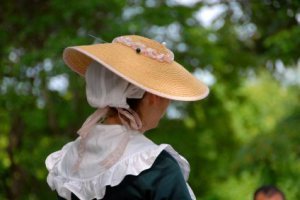 I love Hill’s many references to the ‘charitable lady’ who is concocting herbal medicines for her family or community and he gives painstaking instructions and recipes for making juices, infusions, decoctions, distilled waters, cordials, tinctures, conserves, syrups, oxymels, vinegar of squills, ointments, plaisters (plasters), essential oils…
I love Hill’s many references to the ‘charitable lady’ who is concocting herbal medicines for her family or community and he gives painstaking instructions and recipes for making juices, infusions, decoctions, distilled waters, cordials, tinctures, conserves, syrups, oxymels, vinegar of squills, ointments, plaisters (plasters), essential oils…
His recipe for honey of roses:
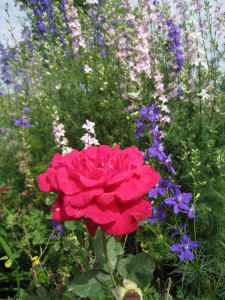 “Cut the white heels from some red rose buds, and lay them to dry in a place where there is a draught of air; when they are dried, put half a pound of them into a stone jar, and pour on them three pints of boiling water; stir them well, and let them stand twelve hours; then press off the liquor (liquid) and when it has settled, add to it five pounds of honey; boil it well, and when it is of the consistence of thick syrup, put it by for use. It is good against mouth sores, and on many other occasions.” (Which means it has many other uses.)
“Cut the white heels from some red rose buds, and lay them to dry in a place where there is a draught of air; when they are dried, put half a pound of them into a stone jar, and pour on them three pints of boiling water; stir them well, and let them stand twelve hours; then press off the liquor (liquid) and when it has settled, add to it five pounds of honey; boil it well, and when it is of the consistence of thick syrup, put it by for use. It is good against mouth sores, and on many other occasions.” (Which means it has many other uses.)
If you are desirous of acquiring a copy of The Family Herbal, I came across a copy, reprinted much in the manner of Hill’s original work, at Amazon.
*Image of red rose and larkspur from our garden by daughter Elise. All images royalty free.
Filed under: Uncategorized Tagged: 18th century, Georgian England, herbal honey, herbal lore, herbal recipe, honey of roses, old herbal, Sir John Hill


January 30, 2014
The Age-Old Uses of Chokecherry
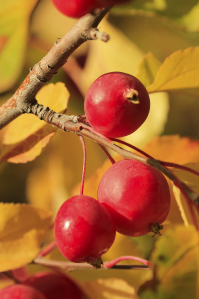 The fruit of the chokecherry is edible raw or cooked, but is harsh tasting, so generally used in jellies and pies. The seeds contain cyanide, readily detected by its bitter taste, so care should be taken not to ingest many seeds. But the uses for this plant are astounding.
The fruit of the chokecherry is edible raw or cooked, but is harsh tasting, so generally used in jellies and pies. The seeds contain cyanide, readily detected by its bitter taste, so care should be taken not to ingest many seeds. But the uses for this plant are astounding.
From Wild Rose College of Natural Healing :
“Chokecherry bark is classified by many Indians as one of their most valued herbs. The bark is listed as bitter, astringent, narcotic, stimulant, mild tonic, sedative and pectoral. Both hot and cold water are used as solvents. All the bark is useful, but the inner bark of the roots is reported to be the best. The bark was used to relieve headache and for “heart trouble” by the Bella Coola people. Herbalists have used it for intermittent fever, worms, dyspepsia, consumption, hectic fever, the congestion of phlegm and bronchitis.”
From Prunus Virginiana L: Medicinal Uses: The inner bark, although the root is always better. “Wild cherry is an herb that has been used for a very long time in herbalism and is mostly noted for its use in respiratory problems. It has a soothing and sedative effect on the respiratory system. Wild cherry soothes the cough. In digestive disorders, it is very noticeable and helps the flow of gastric juices. This is helpful in conditions of dyspepsia.”
From Bear Medicine Herbals : “ Wild cherry is an excellent sedative and tonic, quieting irritation of the mucosa, terminal nerves, and lessening violent cardiac action dependent upon weakness. When a tonic and sedative is desired that will not unduly excite the circulation, wild cherry is a most useful drug. As such it may be used in atonic dyspepsia, and in convalescence from fevers and inflammations, especially after pleurisy, pneumonia, and la grippe.” ~Felter
From Field Guide to Medicinal Wild Plants by Bradford Angier:
“The youngster loved chokecherry grows as both a bushy shrub and as a tree seldom higher than 22 feet, its branches bending with clusters of darkening red or blackish purple berrylike drupes which pucker the mouth but are nevertheless prized by many people, especially children.”
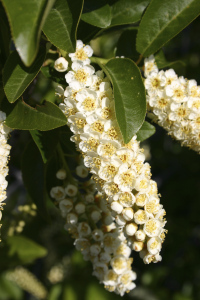 Uses: “It should be noted that the pleasant, bitter, almondlike aroma of these medicinals is due to the presence of small amounts of hydrocyanic acid which, although highly volatile, can be highly poisonous and even fatal. This acid is particularly strong in the inner bark, seeds, and leaves. Despite this, the Indians and therefore the settlers often used some of these in their palliatives and their foods, and the huge amount of fruit devoured never seemed to hurt any of us youngsters.”
Uses: “It should be noted that the pleasant, bitter, almondlike aroma of these medicinals is due to the presence of small amounts of hydrocyanic acid which, although highly volatile, can be highly poisonous and even fatal. This acid is particularly strong in the inner bark, seeds, and leaves. Despite this, the Indians and therefore the settlers often used some of these in their palliatives and their foods, and the huge amount of fruit devoured never seemed to hurt any of us youngsters.”
“In Appalachia today in some remote localities the inner bark or cambium is still used as a flavoring agent in cooking, and a tea made from it is utilized for coughs, cold symptoms, as an expectorant, and for cholera.” (Bear in mind this book was published in the late 1970’s.)
 The dried and pulverized bark was scattered over open sores. It was smoked for headache and was another of the innumerable cold remedies. The bark was steeped to treat anything from measles to stomach trouble, and it was given to women in labor in an effort to relieve their pain. The infusion was also taken for worms, for tuberculosis, as a sedative, and for some fevers. Indians boiled the inner bark and gave an enema with it for hemorrhoids. As has been indicated, a tea brewed from the inner bark seemed to help control nervousness and to allay spasms of the digestive tract.” (Chokecherry was much used by Native Americans)
The dried and pulverized bark was scattered over open sores. It was smoked for headache and was another of the innumerable cold remedies. The bark was steeped to treat anything from measles to stomach trouble, and it was given to women in labor in an effort to relieve their pain. The infusion was also taken for worms, for tuberculosis, as a sedative, and for some fevers. Indians boiled the inner bark and gave an enema with it for hemorrhoids. As has been indicated, a tea brewed from the inner bark seemed to help control nervousness and to allay spasms of the digestive tract.” (Chokecherry was much used by Native Americans)
From: http://www.prairie-elements.ca/chokecherry.html
“The chokecherry was introduced to Europe in the mid-eighteenth Century and was first cultivated in 1724. Its occurrence in North America may have become more widespread as a consequence of deforestation by European settlers.”
***I noted an incorrect reference of the use of chokecherry bark on the mini series World Without End, based on the novel by Ken Follet They didn’t have chokecherries in England in 1327. I also thought the heroine, supposedly a skilled herbalist, should have realized her parents were both poisoned. Other than that, I enjoyed the series for the most part.
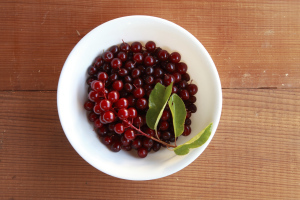 Back to the article: “The fruit were dried and ground, stones and all, for use in soups, stews and pemmican. In the interior of B.C., dried chokecherries were often eaten with salmon or salmon eggs.
Back to the article: “The fruit were dried and ground, stones and all, for use in soups, stews and pemmican. In the interior of B.C., dried chokecherries were often eaten with salmon or salmon eggs.
The bark was boiled along with other ingredients to produce a remedy for diarrhoea. A strong, black, astringent tea was made from boiled twigs and used to relieve fevers. Dried roots were chewed and placed on wounds to stop bleeding. Teas were made from the bark or roots and used to treat coughing, malaria, stomachaches, tuberculosis and intestinal worms. Such teas were also used as sedatives and appetite stimulants. The fruit were used to treat canker sores, ulcers and abscesses.
Wood of the chokecherry was used for tipi construction, bows and arrows, skewers, digging sticks, pipe stems and fire tongs. Navajo Indians thought of the chokecherry as a sacred plant and used its wood to make prayer sticks.”
***Quite a multiuse herb, assuming it doesn’t poison you.
Filed under: Uncategorized Tagged: chokecherry, herbal uses, Herbalism, medicinal uses, Native American, Prunus Virginiana L



